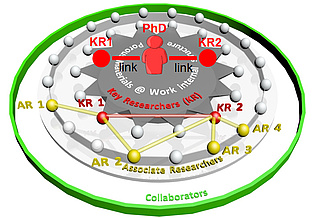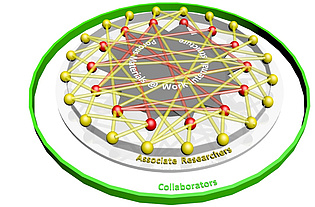
Porous Materials@Work is divided into a set of 11 sub-projects (P1-P11), which typically bundle hitherto unconnected research lines at TU Graz. These sub-projects are part of four focus areas
 Design of new porous materials
Design of new porous materials
 Controlled growth of porous systems
Controlled growth of porous systems
 Application of porous materials in sensing
Application of porous materials in sensing
 Application of porous materials in biotechnology
The structure, resembling a technological platform, was conceived in order to create and consolidate a research network within TU Graz, sharing resources, expertise and equipment. The two key researchers responsible for each project (red spheres in the figures above) jointly supervise a PhD-student and are supported by a variable number of partners who comprise other key researchers, associate researchers (yellow spheres in the figures above), and external collaborators (green ring). These provide specific expertise/equipment for conducting additional tasks required within the sub-project. This setup generates a highly branched structure maximizing interaction between all people involved in the lead project. The actual interaction matrix is shown on the right side above).
Application of porous materials in biotechnology
The structure, resembling a technological platform, was conceived in order to create and consolidate a research network within TU Graz, sharing resources, expertise and equipment. The two key researchers responsible for each project (red spheres in the figures above) jointly supervise a PhD-student and are supported by a variable number of partners who comprise other key researchers, associate researchers (yellow spheres in the figures above), and external collaborators (green ring). These provide specific expertise/equipment for conducting additional tasks required within the sub-project. This setup generates a highly branched structure maximizing interaction between all people involved in the lead project. The actual interaction matrix is shown on the right side above).
Sub-projects
P1: New types of highly conducting and functional COFs and MOFs: Chemistry
P2: New types of highly conducting and functional COFs and MOFs: Structure and Modelling
P3: Routes towards ordered porous metal sulfide layers
P4: Heteroepitaxial growth of MOFs
P5: Vapor deposition of metal-organic nanoporous materials
P6: Pore formation in metals - modeling based on experimental data
P7: Fast optoelectronic sensors based on hydrogels grown under nanoconfinement
P8: Micro-fluidic sensor platform based on cellulose materials and mesoporous hybrids
P9: Porous materials for optical sensing of methane
P10: Application potentials of nanoporous metals in biocatalysis
P11: Porous biocomposites based on enzyme encapsulated into MOFs

